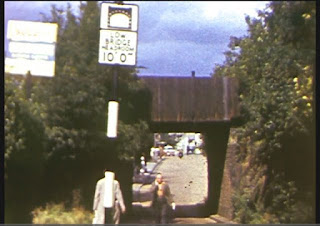 We might celebrate it as a diamond jubilee of events which occurred sixty years ago – 1957. Some of us were elsewhere then, too young, or not born, to recall, others not here today to remember that year they were a part of.
We might celebrate it as a diamond jubilee of events which occurred sixty years ago – 1957. Some of us were elsewhere then, too young, or not born, to recall, others not here today to remember that year they were a part of.If you were aspiring to purchase a home in 1957 and desired Marshalswick as a location, new homes on the Nash estate would cost you £2,500. You would apply at the farmhouse on the part-complete estate. This was the final full year of the historic farmhouse, before work began on clearance for the high-density developments of flats and The Quadrant shopping area.
A crowd-attracting event for supporters of St Albans Cricket Club and for Clarence Park, was a July benefit match against Surrey CC. The benefit was for Surrey's David Fletcher, and the boundary was lined with enthusiasts on what turned out to be warm and calm weather conditions.
 |
| Sponsored by Interflora COURTESY HERTS ADVERTISER |
St Albans residents were treated to a colourful advanced view of a parade float sponsored by Interflora. It consisted of dahlia blooms from the nursery of Ernie Cooper, who had his trial grounds where Longacres Park is today. Just imagine seeing this photo in glorious colour.
We have grown so used to the road layout as we approach Hatfield that we have no idea what it was previously like; to pass The Comet Hotel on the right; join the North Orbital Road (now Comet Way) at traffic lights; immediately join the right lane and wait for the green to enter St Albans Road at The Stone House (Galleria car park today) en-route to Hatfield centre. In 1957 we had an additional obstruction: the contractors building our now-familiar Comet roundabout. Cavendish Way was being constructed towards Bishops Rise – and just look how many trees are still visible.
 |
| Comet Roundabout under construction COURTESY HERTS ADVERTISER |
 |
| We can't really call the section on the right Old London Road, but that is what it is. The print from the other side of the newsprint page shows through. COURTESY HERTS ADVERTISER |
Another new road was being carved out of the fields to divert London Road, near the cemetery, towards a new London Colney Roundabout and then a new A6 bypass for the village. Today we can still use the section where the lorries in the photo are, but it leads nowhere. That was in 1957 too.
Now, the big news. Well it was for some residents of south Hatfield. On a November night a number of new houses in the district lost their roofs in the strong winds which swept the county. Their occupants, after recovering from the shock, were found emergency accommodation, and the dreadful event was a major feature of the national news.
 |
| The scene in Shallcross Crescent, Hatfield, the following morning. COURTESY HERTS ADVERTISER |
A new term was launched in the district, especially among families with employees at de Havilland. Firestreak. This related to work being undertaken at the Hatfield site on its new guided weapons system. That was quite a jump from the "Wooden Wonder" Mosquito war plane production line of fifteen years earlier.
Oh, and I made it to my teens.








